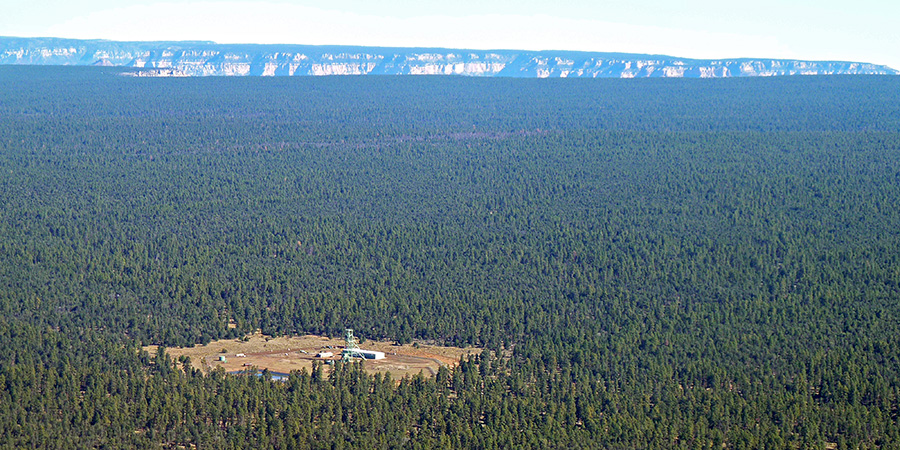
Canyon Mine, aka Pinyon Plain Mine, is extracting uranium near the Grand Canyon for the first time in its nearly 40-year history.
Mere months after the long-awaited and widely celebrated designation of Baaj Nwaavjo I’tah Kukveni – Ancestral Footprints of the Grand Canyon National Monument, a controversial uranium mine within the monument boundaries is starting operations, according to the mine’s owner.
Although the monument bans new uranium mines, Canyon Mine (renamed Pinyon Plain Mine) was exempted from this ban. The Havasupai Tribe, the Grand Canyon Trust, and many others worked for years to try to stop the mine in the courts.
The White House Baaj Nwaavjo I’tah Kukveni National Monument fact sheet mentions two mining operations within the monument that would be able to operate. The second one is likely Arizona One uranium mine, on the north rim of the Grand Canyon. But Arizona One has been mined out since 2014.
Stockpiling uranium ore near the Grand Canyon
In November, Energy Fuels Resources, which owns and operates Pinyon Plain Mine, sent a required notice to the U.S. Environmental Protection Agency. The notice indicated that ventilation of the mine would begin within 30 to 60 days. Ventilation is required for miners to work underground.
The company also indicated to the Kaibab National Forest, which manages the monument lands where the mine sits, that it expected to begin extracting radioactive uranium ore and piling it up at the mine site sometime in December or early January. Ore is typically left uncovered. High winds can blow radioactive dust into the national forest.
On December 21, 2023, Energy Fuels put out a press release announcing it had “commenced uranium production” at Pinyon Plain Mine alongside two other mines on the Colorado Plateau.
The mine has occupied national forest lands within the Havasupai Tribe’s Red Butte Traditional Cultural Property for nearly four decades. Yet this is the first time the mine has operated. Mining starting coincides with spot prices for uranium soaring to over $90, their highest point in over a decade.
Uranium mine moves ahead despite national monument protections

The Havasupai Tribe, the Grand Canyon Trust, and partners spent years in court attempting to stop Canyon Mine (Pinyon Plain Mine). Unfortunately, in February 2022, a federal court cleared the path for the mine to move forward.
This means that although Baaj Nwaavjo I’tah Kukveni National Monument bans all new uranium mines on monument lands around the Grand Canyon, the ban doesn’t apply to Canyon Mine (Pinyon Plain Mine). Canyon Mine is considered exempt.
Why can a mine be exempted from a ban on mining?
When mining bans are put in place, the government has to leave space for existing mines to continue if they have what are called “valid existing rights” under the 1872 Mining Law. So if a mine has demonstrated that it can profitably mine a valuable mineral deposit before a mining ban takes effect, it can move ahead regardless of later bans.
In the case of Canyon Mine (Pinyon Plain Mine), the February 2022 court ruling upheld the Forest Service’s determination that the mine has valid existing rights. This exempted it from the mining ban. Unfortunately, the permissive nature of the 1872 Mining Law means that the mine is allowed to move ahead, despite its location near the south rim of Grand Canyon National Park, inside the newly designated Baaj Nwaavjo I’tah Kukveni National Monument
Groundwater quality and cultural sites at risk

With Canyon Mine (Pinyon Plain Mine), a lot is at risk. First, the mine sits overtop the Redwall-Muav Aquifer, the sole water source for the Havasupai Tribe. The aquifer is the source of many seeps and springs inside Grand Canyon National Park.
Since 2016, tens of millions of gallons of precious groundwater contaminated with high levels of dangerous minerals like uranium and arsenic have been pumped out of the mine. The mine operator has left that water to evaporate in an open-air pond. It has also misted into the air, and even trucked it over state lines to the White Mesa uranium mill for disposal. This groundwater inflow will continue to pose a threat to the greater groundwater system long after the mine closes down.
The mine is also not only within the Red Butte Traditional Cultural Property fewer than 10 miles from Grand Canyon National Park, it’s also now within the south parcel of the new Baaj Nwaavjo I’tah Kukveni National Monument. This area remains deeply significant to the Havasupai, Hopi, and other regional tribes.
What can be done to protect the Grand Canyon region from uranium mining?

The biggest lever for protection was the designation of the new Baaj Nwaavjo I’tah Kukveni National Monument. That lever has thankfully already been pulled. It will prevent new mines from ever coming online inside the monument boundaries. Which means the threat of hundreds of new uranium mines is lifted.
When it comes to Canyon Mine (Pinyon Plain Mine) specifically, the options have narrowed. Here are a few things that can be done:
- First, we can continue to monitor the mine and its operations for any missteps that violate legal safeguards. We can continue to report these violations to the proper authorities.
- Second, we can make sure that when the mine finishes operating — expected to take only two to three years once the company starts extracting uranium — the mine owner follows the closure plan.
- And third, we can work to ensure that no other existing mines in the region are able to secure an exception like Canyon Mine (Pinyon Plain Mine) has.





